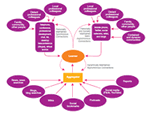Aggregators such as Google
Reader, Netvibes and Pageflakes are now at the core of many educators’ PLNs because they bring us information that helps us do our jobs. In a sense, this technology has inspired a shift from a hunting and gathering information economy to the domestication of the information landscape. When you subscribe to tagged Flickr photos, new videos from YouTube or TeacherTube, Google News searches or podcasts, you are training all this information to organise and deliver itself to you. For example, after finding an education blog through a blog search on Technorati, you can subscribe to its RSS feed with your aggregator. Then you can sit back and relax, waiting for the software to periodically check for new posts, retrieve them as they appear and make them available for reading at your leisure.
 You can also subscribe to ongoing blog searches that will scan the entire blogosphere and automatically send to you new posts on your chosen topic. Some of the most useful PLN tools are social bookmarking services such as Delicious. As people add new websites to their online bookmarks and categorise or tag them, that information becomes available to the entire community. Click here to view a diagram of The Networked Learner.
You can also subscribe to ongoing blog searches that will scan the entire blogosphere and automatically send to you new posts on your chosen topic. Some of the most useful PLN tools are social bookmarking services such as Delicious. As people add new websites to their online bookmarks and categorise or tag them, that information becomes available to the entire community. Click here to view a diagram of The Networked Learner.
